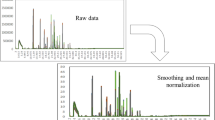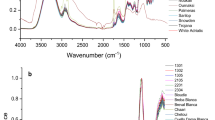Abstract
Alternative food sources are of importance in order to replace traditional and less sustainable ingredients for human consumption. In recent years, edible insects have been found to be an alternative source of proteins, lipids and fibre. The aim of this study was to evaluate the use of attenuated total reflectance–mid infrared (MIR) spectroscopy as a rapid tool to qualitatively characterise the chemical composition of edible green ant samples from Australia. Edible green ant anatomical parts (whole, abdomen and upper body plus legs), pre-processing (powdered and non-destructive) and material freshness (old and fresh) were analysed using attenuated total reflectance (ATR) MIR spectroscopy. Principal component analysis (PCA) of the MIR data allowed clustering samples according to body part. The main separation was driven by the composition of the abdomen, irrespective if the ants were analysed in a powdered form or as a whole. The MIR method was also able to identify a mild effect of storage conditions (e.g. freshness of the sample). It was concluded that MIR spectroscopy might be a promising tool to pre-screen edible insect composition and to evaluate the effect of storage.






Similar content being viewed by others
References
Brugnerotto J, Lizardi J, Goycoolea FM, Argüelles-Monal W, Desbrières J, Rinaudo M (2001) An infrared investigation in relation with chitin and chitosan characterization. Polymer 42:3569–3580
Bureau S, Cozzolino D, Clark CJ (2019) Contributions of Fourier-transform mid infrared (FT-MIR) spectroscopy to the study of fruit and vegetables: a review. Postharvest Biol Technol 148:1–14
Chakravorty J, Ghosh S, Megu K, Jung C, Meyer-Rochow VB (2016) Nutritional and anti-nutritional composition of Oecophylla smaragdina (Hymenoptera: Formicidae) and Odontotermes sp. (Isoptera: Termitidae): two preferred edible insects of Arunachal Pradesh, India. J Asia Pac Entomol 19:711–720
Defoliart GR (1995) Edible insects as minilivestock. Biodivers Conserv 4:306–321
Gibbs A, Crowe JH (1991) Intra-individual variation in cuticular lipids studied using Fourier transform infrared spectroscopy. J Insect Physiol 37:743–748
Guillén MD, Cabo N (1997) Infrared spectroscopy in the study of edible oils and fats. J Sci Food Agric 75:1–11
Hamed SF, Mousa AA (2006) Application of FTIR spectroscopy in the determination of antioxidant efficiency in sunflower oil. Res J Appl Sci 2:27–33
Iconomidou VA, Chryssikos GD, Gionis V, Willis JH, Hamodrakas SJ (2001) “Soft”-cuticle protein secondary structure as revealed by FT-Raman, ATR FT-IR and CD spectroscopy. Insect Biochem Mol 31:877–885
Jang M-K, Kong B-G, Jeong Y-I, Lee CH, Nah J-W (2004) Physicochemical characterization of α-chitin, β-chitin, and γ-chitin separated from natural resources. Wiley Intersci Online 42:3423–3432
Karoui R, Downey G, Blecker C (2010) Mid-infrared spectroscopy coupled with chemometrics: a tool for the analysis of intact food systems and the exploration of their molecular structure-quality relationships - a review. Chem Rev 110:6144–6168
Kouřimská L, Adámková A (2016) Nutritional and sensory quality of edible insects. NFS J 4:22–26
Ladrón de Guevara O, Padilla P, García L, Pino JM, Ramos-Elorduy J (1995) Amino acid determination in some edible Mexican insects. Amino Acids 9:161–173
Lockers C (1990) Colony dynamics of the green tree ant (Oecophylla smaragdina Fab.) in a seasonal tropical climate. Doctoral dissertation. James Cook University
Movasaghi Z, Rehman S, ur Rehman DI (2008) Fourier transform infrared (FTIR) spectroscopy of biological tissues. Appl Spectrosc Rev 43:134–179
Moya Moreno MCM, Mendoza Olivares D, Amézquita López FJ, Gimeno Adelantado JV, Bosch Reig F (1999) Determination of unsaturation grade and trans isomers generated during thermal oxidation of edible oils and fats by FTIR. J Mol Struct 482-483:551–556
Naes T, Isaksson T, Fear T, Davies T (2002) A user-friendly guide to multivariate calibration and classification. NIR Publications, Chichester
Offenberg J (2011) Oecophylla smaragdina food conversion efficiency: prospects for ant farming. J Appl Entomol 135:575–581
Pallone Azevedo Lima J, Caramês dos Santos ET, Alamar Domingues P (2018) Green analytical chemistry applied in food analysis: alternative techniques. Curr Opin Food Sci 22:115–121
Povea MB, Argüelles-Monal W, Cauich-Rodríguez JV, May-Pat A, Badas-Rivero N, Peniche-Covas C (2011) Interpenetrated chitosan-poly (acrylic acid-co-acrylamide) hydrogels. Synthesis, characterization and sustained protein release studies. J Mater Sci Appl 2:11
Rumpold BA, Schlüter OK (2013) Nutritional composition and safety aspects of edible insects. Mol Nutr Food Res 57:802–823
Savitzky A, Golay MJE (1964) Smoothing and differentiation of data by simplified least squares Procedures. Anal.Chem. 36:1627–1639
Sogari G, Bogueva D, Marinova D (2019) Australian Consumers’ Response to Insects as Food. Agriculture 9:108
Srivastava AK, Iconomidou VA, Chryssikos GD, Gionis V, Kumar K, Hamodrakas SJ (2011) Secondary structure of chorion proteins of the Lepidoptera Pericallia ricini and Ariadne merione by ATR FT-IR and micro-Raman spectroscopy. Int J Biol Macromol 49:317–322
Tiencheu B, Womeni HM, Linder M, Mbiapo FT, Villeneuve P, Fanni J et al (2013) Changes of lipids in insect (Rhynchophorus phoenicis) during cooking and storage. Eur J Lipid Sci Technol 115:186–195
Tzompa Sosa DA, Fogliano V (2017) Potential of insect-derived ingredients for food applications
van de Voort FR, Ismail AA, Sedman J, Dubois J, Nicodemo T (1994a) The determination of peroxide value by fourier transform infrared spectroscopy. J Am Oil Chem Soc 71:921–926
van de Voort FR, Ismail AA, Sedman J, Emo G (1994b) Monitoring the oxidation of edible oils by Fourier transform infrared spectroscopy. J Am Oil Chem Soc 71:243–253
van Huis A (2013) Potential of insects as food and feed in assuring food security. Annu Rev Entomol 58:563–583
Wilkinson K, Muhlhausler B, Motley C, Crump A, Bray H, Ankeny R (2018) Australian consumers’ awareness and acceptance of insects as food. Insects 9:44
Acknowledgements
The authors acknowledge the Larrakia People who are the Traditional Owners of the lands on which the green ants were wild-harvested and respect the knowledge and experience the Traditional Owners hold regarding the care, harvest and use of this insect species.
Funding
This project was funded by the University of Queensland, Australia, The Australian Research Council Transformational Training Centre for Uniquely Australian Foods Grant number IC180100045.
Author information
Authors and Affiliations
Corresponding author
Ethics declarations
Conflict of Interest
Yasmina Sultanbawa declares that she has no conflict of interest. Sandra M. Olarte Mantilla declares that she has no conflict of interest. Daniel Cozzolino declares that he has no conflict of interest. Shanmugam Alagappan declares that he has no conflict of interest. Heather. E. Smyth declares that she has no conflict of interest.
Ethical Approval
This article does not contain any studies with human participants or animals performed by any of the authors.
Informed Consent
Not applicable.
Additional information
Publisher’s Note
Springer Nature remains neutral with regard to jurisdictional claims in published maps and institutional affiliations.
Rights and permissions
About this article
Cite this article
Mantilla, S.M.O., Alagappan, S., Sultanbawa, Y. et al. A Mid Infrared (MIR) Spectroscopy Study of the Composition of Edible Australian Green Ants (Oecophylla smaragdina)—a Qualitative Study. Food Anal. Methods 13, 1627–1633 (2020). https://doi.org/10.1007/s12161-020-01783-7
Received:
Accepted:
Published:
Issue Date:
DOI: https://doi.org/10.1007/s12161-020-01783-7




